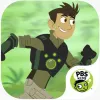Take a look inside 8 images
Wild Kratts Rescue Run
Pros: Take on the role of different animals to use their skills; learn some animal and ecosystem basics.
Cons: Material doesn't offer much depth; levels don't allow backtracking for true exploration.
Bottom Line: This app provides students with a limited but useful introduction to ecosystems and the survival skills of animals.
Teachers can use Wild Kratts Rescue Run as a fun introduction to animals and ecosystems for young students as part of a science lesson. Teachers can adjust the running speed in the app to one of five levels, depending on student age and skill, but it's helpful to start everyone on a slower speed until they get oriented to the game's format. They can then adjust their own speed as they play, between levels, or from the pause screen.
Since levels are played in one direction, moving left to right, students can't backtrack to try other paths (unless they are in hummingbird form, but then they can only explore a small area), so warn them of this in advance. If students get discouraged, let them know that they don't need to earn all three stars on the same playthrough of a level. If they gather enough paw prints but can't find the trapped animal, for example, next time they can focus on finding the animal without worrying about the paw prints. They'll get credit for each type of star they earn in the end.
Wild Kratts Rescue Run is an animal and ecosystem discovery app for young students. The story is that villains have stolen wild animals, trapping them in pods, and it's up to the players to locate and free them. Based on the PBS Kids series Wild Kratts, this app has students donning Creature Power Suits to take on the skills and abilities of different animals as they navigate a (mostly) one-way course through platformer levels. They run, jump, fly, and swim to collect paw prints, rescuing animals along the way, and then they defeat the animal-napping villains. Once players rescue an animal, that animal's information is unlocked in the Creaturepedia, which students can access at any time to learn more about that animal and its habitat. There are 21 animals in all, such as a bald eagle, a kangaroo, and an orca. Students earn a star each for completing the level, collecting enough paw prints, and rescuing animals. Players lose some gathered paw prints, however, if they run into other animals.
After running through a quick tutorial and learning how to use the Jump and Creature Power buttons, students choose from among three ecosystem missions -- South American rainforest, Australian Outback, and a snowy North American forest -- each of which has eight replayable levels to complete, including a final level where they can defeat the villain. Each time players start a new level, they choose which of the three Wild Kratts characters to be: Chris, Martin, or Aviva. Each one has his or her own set of Creature Power Suits to draw from. Students can also choose their running speed from one of five speeds.
While Wild Kratts Rescue Run is simple and straightforward, getting three stars on every level the first time through isn't assured. Students will need to use their problem-solving skills to gather enough paw prints, locate and free the trapped animals, and make it to the finish while using the Creature Power Suit powers to their best advantage. Since levels can be replayed, however, students get unlimited shots at success. This is helpful when students choose routes that don't lead to the trapped animal, since players can't turn around. Backtracking isn't an option, so a bit of trial and error may be required. This teaches students to remember where they saw the trapped animal and to head in that direction for their next attempt, encouraging perseverance.
The entries in the Creaturepedia give an intro to students for each animal, but the information included is pretty basic. The app does read the entries out loud as well as show them in print, and game tips are also spoken out loud as students play through the levels, so being a non-reader isn't a barrier to entry. The game levels go by pretty quickly, though, even on the slowest speed, so students don't have time to study the ecosystems they're exploring or the animals who inhabit them. There's some knowledge to be gained here, especially for younger students, but sometimes it feels like learning is tangential to gameplay.


















